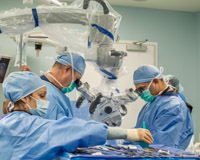Cervical degenerative disc disease is a common condition that affects the discs in the neck, leading to pain, stiffness and reduced mobility. While the condition can be difficult to deal with, targeted exercises can help alleviate symptoms, improve flexibility and strengthen the supporting muscles to help manage cervical degenerative disc disease and improve overall neck health.
What is Cervical Degenerative Disc Disease?
Cervical degenerative disc disease occurs when the intervertebral discs in the neck start to break down due to aging, wear and tear or injury. This degeneration can lead to symptoms such as:
- Chronic neck pain and stiffness
- Headaches
- Reduced range of motion
- Numbness or tingling in the arms
- Muscle weakness in the shoulders or arms
Regular exercise can play a vital role in managing symptoms by enhancing spinal stability, reducing tension and improving circulation in the affected areas.
However, before starting any exercise regimen, speak to your doctor or physical therapist to make sure the exercises are safe to perform, and consider these additional precautions:
- Perform movements gently and avoid sudden or jerky motions.
- Stop any exercise that causes sharp pain or discomfort.
- Maintain good posture while exercising to prevent strain on the cervical spine.
- Perform exercises in a slow and controlled manner to maximize benefits.
 "Movement is medicine. But remember – move smart. Start slow, avoid jerky motions, and always listen to your body. If something hurts, stop. And before diving in, check with your doctor or physical therapist to make sure your routine is safe. But I'm often advising my degenerative disc patients – both ones who don't need surgery and sometimes even those who are pre or post op – to incorporate neck stretches that help with degenerative disc disease in the neck."
"Movement is medicine. But remember – move smart. Start slow, avoid jerky motions, and always listen to your body. If something hurts, stop. And before diving in, check with your doctor or physical therapist to make sure your routine is safe. But I'm often advising my degenerative disc patients – both ones who don't need surgery and sometimes even those who are pre or post op – to incorporate neck stretches that help with degenerative disc disease in the neck."
Amer Khalil, MD | Neurosurgeon Specializing in Minimally Invasive Spine
Effective Exercises for Cervical Degenerative Disc Disease
1. Chin Tucks
Chin tucks help strengthen the deep neck flexors and improve posture.
How to do Chin Tucks:
- Sit or stand with a straight spine.
- Gently tuck your chin in, as if making a double chin.
- Hold for 5 seconds, then relax.
- Repeat 10 times.
2. Neck Retraction (Cervical Retraction)
This exercise helps improve posture and alleviate pressure on the cervical spine.
How to do Neck Retraction:
- Sit with your back straight.
- Pull your head straight back while keeping your eyes forward.
- Hold for 5 seconds, then return to the starting position.
- Repeat 10 times.

3. Neck Side Bends
This movement increases flexibility and reduces stiffness in the neck.
How to do Neck Side Bends:
- Sit or stand with your shoulders relaxed.
- Slowly tilt your head toward one shoulder until you feel a gentle stretch on the opposite side.
- Hold for 10-15 seconds, then return to the starting position.
- Repeat on the other side.
- Perform 3-5 repetitions per side.
4. Neck Rotations
This exercise enhances range of motion and reduces stiffness.
How to do Neck Rotations:
- Sit or stand with good posture.
- Slowly turn your head to one side until you feel a stretch.
- Hold for 10-15 seconds, then return to the center.
- Repeat on the other side.
- Perform 3-5 repetitions per side.
 “I know a lot of patients, when I tell them some light stretches might help alleviate their pain, will be kind of surprised. Like, movement or stretching could make their pain worse. But when the conditions are right, patients who struggle with cervical degenerative disc disease can absolutely see benefits from stretches – neck rotations, neck side bends, those sorts of things. But again, they should confirm with their specialist that stretching is safe before trying it at home. ”
“I know a lot of patients, when I tell them some light stretches might help alleviate their pain, will be kind of surprised. Like, movement or stretching could make their pain worse. But when the conditions are right, patients who struggle with cervical degenerative disc disease can absolutely see benefits from stretches – neck rotations, neck side bends, those sorts of things. But again, they should confirm with their specialist that stretching is safe before trying it at home. ”
Nick Jain, MD | Spine Surgeon
5. Shoulder Blade Squeezes
Strengthening the upper back muscles helps support the cervical spine.
How to do Shoulder Blade Squeezes:
- Sit or stand with your shoulders relaxed.
- Squeeze your shoulder blades together as if holding a pencil between them.
- Hold for 5 seconds, then release.
- Repeat 10 times.
6. Upper Trapezius Stretch
This stretch helps relieve tension in the upper shoulders and neck.
How to do an Upper Trapezius Stretch:
- Sit or stand upright.
- Gently tilt your head to one side while holding onto the opposite side of your head for a deeper stretch.
- Hold for 15-20 seconds.
- Repeat on the other side.
- Perform 2-3 repetitions per side.
7. Levator Scapulae Stretch
This stretch targets the muscle that connects the neck to the shoulder blade.
How to do a Levator Scapulae Stretch:
- Sit with good posture.
- Turn your head slightly to one side and tilt it downward as if looking at your armpit.
- Gently use your hand to deepen the stretch.
- Hold for 15-20 seconds, then switch sides.
- Repeat 2-3 times per side.
8. Isometric Neck Strengthening
These exercises help strengthen neck muscles without excessive movement.
How to do Isometric Neck Strengthening:
- Place your palm on your forehead and gently push against it while resisting the movement with your neck.
- Hold for 5 seconds, then relax.
- Repeat the process with your palm on the back of your head and then on each side.
- Perform 5 repetitions in each direction.
Additional Tips for Managing Cervical Degenerative Disc Disease
In addition to the stretches and exercises mentioned above, here are some tips on how to manage cervical degenerative disc disease:
- Maintain Good Posture: Keep your head aligned with your spine to reduce strain.
- Use Ergonomic Support: Ensure your workstation and pillow provide adequate support.
- Stay Active: Avoid prolonged periods of inactivity, which can increase stiffness.
- Apply Heat or Ice: Heat can relax muscles, while ice can reduce inflammation and pain.
- Practice Stress Management: Techniques like yoga, meditation, or deep breathing can help reduce tension in the neck.
Cervical degenerative disc disease can be painful, but incorporating gentle stretches and exercises into your daily routine can significantly improve symptoms and enhance overall neck health. Always consult a healthcare provider before beginning a new exercise program, and listen to your body to ensure movements are beneficial. By maintaining an active and mindful approach, you can reduce discomfort and improve your quality of life. If you’ve tried the above conservative care treatments and are still experiencing pain, or experiencing pain that is debilitating, consider making an appointment with one of our specialists at DISC.
ARTICLE CATEGORIES: Patient Education, Cervical Discs, Spine, Degenerative Disc Disease

About the author
discmdgroup DISC Sports & Spine Center (DISC) is a national leader in minimally invasive spine surgery, orthopedic surgery, and sports medicine care. Our spine surgeons set the standard in artificial disc replacement, spine fusion, discectomy, microdiscectomy and the full spectrum of spine procedures. The group’s orthopedic surgeons advance the state of joint preservation surgery and total joint replacement, including total knee replacement as well as total hip replacement. Our flagship surgery centers based in Newport Beach, Marina del Rey, and Carlsbad serve patients local to Los Angeles, Orange County and San Diego, as well as the rest of the country. Read more articles by discmdgroup.






